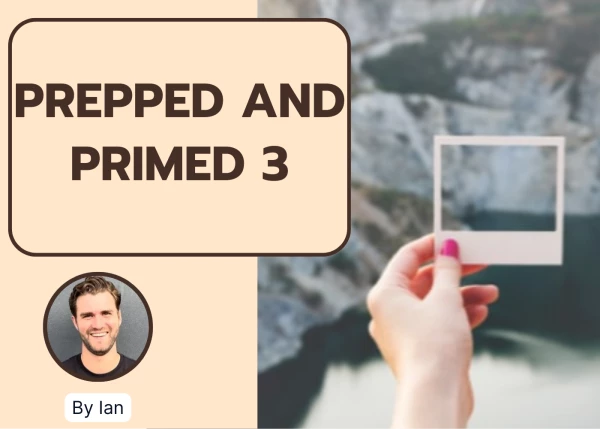Hello, I have an upcoming final round of interview and I'll have to solve a case study. Here is the structure: “You will be given the instructions by the team when you arrive and have one hour to prepare a case study. Afterwards, you will have 45 minutes to present as well as have time for a Q&A with the panel.”
Can you give me some tips on how to prepare? Since I will also have to create a powerpoint
Case study Powerpoint Interview


Hi there,
First, good luck!
I have 30+ REAL written cases AND 100+ killer powerpoint slides.
I provide both to my candidates so feel free to reach out!
What I generally do with my candidates is, give them a few real written case x hours before our scheduled session. In session we then review + work through the cases (getting that mindset shift on how to optimally parse through all the info and create an optimal presentation)

===================WHAT TO EXPECT============
Scenario A: A Prompt with no additional info
Scenario B (most common): A Prompt with way too much information (20+ charts/exhibits)
Scenario C: A prompt with supporting excel sheet/data that you need to parse + create charts/exhibits with
Scenario D (least common): A prompt with the exact data/info/charts you need (every exhibit/chart matters)
Don't worry, I have practice cases for all of these scenarios.
=======HOW TO DO WELL========
While each scenario requires a different approach, the fundamentals are the same.
- Remember that most casing tips apply here (i.e. be very clear+focused on the objective, ruthlessly cut out information that doesn't help you meet this objective/question, get your story right, make sure to think + communicate in a structured way, etc. etc.)
- Practice/simulate this as much as possible beforehand...getting a coach to help you run through scenarios + how to react in inevitably challenging moments will do a world of good.

Hi there,
Q: Can you give me some tips on how to prepare?
In general, for a written case study I would recommend the following.
- - - - - - - - - - - - - - - - - - - - - - - - - - - - - - - - - - - - - - - - - - - - - - - - - - - - - - - - - - - - - - - - - - - -
1. Prepare in advance with other case study
You should be able to find a few written cases online to use for your self-prep. Ideally, the cases should include:
- Graph interpretation
- Math calculation
- The amount of information you expect for your interview (if unknown, I would target at least 10-20 slides/pages)
2. Outline an action plan to analyze the material
If you have 45 minutes to review the material, a possible time schedule is the following (to adapt based on the amount of information and questions):
- 2 min – Read the questions
- 10-15 min – Read the material
- 10 min – Structure the approach
- 15-20 min – Perform math/ Identify answers/ Create slides
- 3 – Final review
The time to read the material depends on how much material you will receive.
3. Define a strategy to present your results
To present your findings in the second part, I would suggest keeping the same structure used for a conclusion in a live interview, that is:
- Summarize the main questions you have to answer
- Present your proposed answers and detail the motivation behind
- Present risks and next steps for the areas you have not covered
- - - - - - - - - - - - - - - - - - - - - - - - - - - - - - - - - - - - - - - - - - - - - - - - - - - - - - - - - - - - - - - - - - - -
To present the slides, I would recommend taking into account the following:
A) Structure of the presentation
Normally the structure for a 5-slide presentation is the following:
- 1st slide – summary of the questions and your answers
- 2nd, 3rd and 4th slides - supporting arguments for the first slide
- 5th slide - risks and next steps
If you can prepare more slides, you can expand slides 2, 3 and 4 accordingly.
B) Content of each slide
There are 3 basic components for most slides:
- Title
- Written content
- Graphs / Tables
Many candidates structure the title as a mere description of what the chart/content is about.
A great title instead shows the implication of the graph/content as well.
Example: say a graph is showing a cost structure for a division.
- A bad title would be: “Cost structure from 2005 to 2015”.
- A good title would be: “Cost structure of Division XYZ is not sustainable”.
- A great title would be “Cost structure of Division XYZ is not sustainable due to ABC”, assuming you have insights on that.
The rule of thumb is that if you read all the titles of the slides, you should get a clear idea of the message of the presentation.
C) Presentation of the slides
When you present, I would recommend the following steps for each slide:
- Introduce the slide: “Let’s move to slide 2, which will show us why we have an issue with this division”
- Present the main message of the slide: “As you can see, we have a cost structure that makes it unfeasible to be competitive in this market”
- Provide details: “The graph, indeed, shows how our fixed cost is XYZ, while competitors can benefit from economies of scale. Indeed…”
- - - - - - - - - - - - - - - - - - - - - - - - - - - - - - - - - - - - - - - - - - - - - - - - - - - - - - - - - - - - - - - - - - - -
If you need more help please feel free to PM me, I do a session specifically on written cases.
Good luck!
Francesco

Hey there,
I have a few tips for written case interviews as well:
#1 Already have a plan when you go in for the written case
Since time is usually limited, you should have a plan on how long you want to spend on each task of the assignment beforehand.
#2 Focus – quickly separate crucial information from the noise
Written cases usually present you with an information overload that you need to sort out
#3 Graphs and charts – interpret and distill key insights from graphs and charts
Written cases bombard you with charts, graphs, tables, and other visual depictions of data that you should use to test your hypotheses. Learn how to quickly read and interpret them
#4 Math – quickly draft equations and conduct pen-and-paper math
Get into the habit of quickly setting up and simplifying calculations
#5 Storyline – draft a compelling storyline and tell it with visually appealing outputs
Create a top-down storyline of your recommendations. State your primary recommendation, then use supporting arguments to strengthen your position
#6 Presentation and defense – communicate and defend your recommendation top-down
If you have to present your findings at the end of the case, follow the top-down approach of your slide deck. Be confident and engaging when going through your recommendations and supporting arguments.
All the best,
Florian

You need to use a written case material to prepare.
The difference vs. a normal case is that you have to be fast at finding the right information and setting up 4-5 slides to communicate your findings.
You should try to do a couple of written cases, and train extensively your exhibit reading skills.

Hi there!
This is a written case.
I see Francesco has already shared a structure below.
Happy to share a couple of sample cases for you to practice. Reach out.
Best,
Cristian

Hi,
I could share a couple of tips - based on practical experience having done this for 9 years in consulting :)
Drop me a dm and I can share more details.














